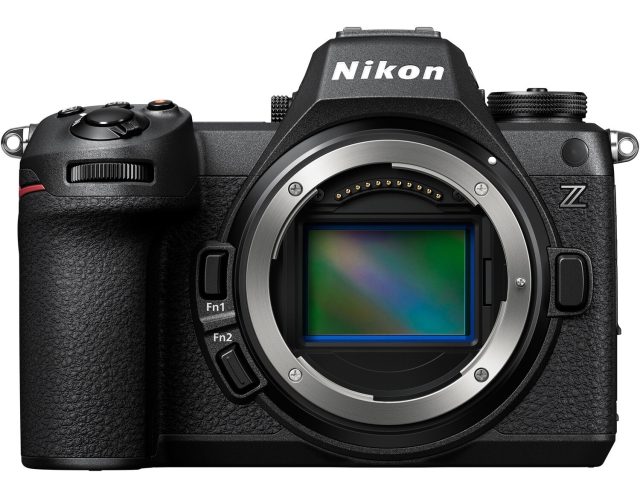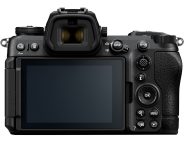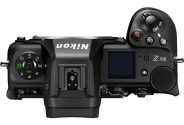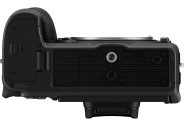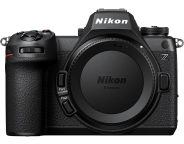Announced
System
Nikon Z system cameras
Nikon Z 6III
35mm AF digital mirrorless camera
Specification
| Format: | |
| 35mm full frame | |
Imaging sensor: | 35.9 × 23.9mm CMOS sensor |
Resolution: | 6048 × 4032 - 24 MP |
Sensor-shift image stabilization: | Yes |
| Nikon Z [16mm] | |
| Shutter: | |
Type: | Focal-plane |
Model: | Electronically controlled |
Speeds: | 30 - 1/16000 + B |
| Exposure: | |
Exposure metering: | Through-the-lens (TTL), open-aperture |
Exposure modes: | Programmed Auto |
| Aperture-priority Auto | |
| Shutter-priority Auto | |
| Manual | |
| Physical characteristics: | |
Weight: | 760g |
Dimensions: | 138.5x101.5x74mm |
Manufacturer description
TOKYO - Nikon Corporation (Nikon) is pleased to announce the release of the full-frame/FX-format Nikon Z6III mirrorless camera for which the Nikon Z mount has been adopted.
The Z6III inherits the same superior performance and operability as the Nikon Z9, the flagship model of the Nikon Z series, and the Nikon Z8. It also offers new signature features and has an effective pixel count of 24.5 megapixels. As the world's first full-frame mirrorless camera to be equipped with a partially-stacked CMOS sensor and the EXPEED 7 image-processing engine used by the Z9 and Z8, the Z6III is better able to capture moving subjects and provides the video recording functions needed to satisfy video production needs. The Z6III is fully equipped with the latest features and offers advanced performance, including an electronic viewfinder (EVF) that is brighter, has a higher resolution, and a wider color gamut than flagship models. Further, the Z6III works in tandem with Nikon's new cloud service, Nikon Imaging Cloud, which offers new Imaging Recipes that expand possibilities for imaging expression. It also allows for the automatic transferring of images captured with the Z6III to various third-party cloud storage services, significantly enhancing user convenience and enjoyment. The Z6III supports both creators who want to tackle more creative imaging expressions and professionals who make their living with their cameras.
Nikon will continue to pursue new dimensions in optical performance while meeting users' needs, contributing to the development of imaging culture, with the hope of expanding possibilities for imaging expression.
Primary features
1. Superior shooting performance realized by the world's first partially-stacked CMOS sensor
The Z6III is the world's first full-frame mirrorless camera for which a partially-stacked CMOS sensor with numerous high-speed processing circuits stacked above and below the image sensor has been adopted. The high-speed readout enabled by this new sensor, along with the EXPEED 7 high-speed image-processing engine, also adopted in the Z9 and Z8, allows for Pre-Release Capture* of up to 1 second of recording before the shutter-release button is fully pressed at a maximum speed of 120 fps (C120). At 60 fps (C60), it can also capture full-frame images with approximately 24 megapixels — a higher pixel count than is supported with the Z9 and Z8. In addition, the EVF display minimizes frame skipping, ensuring smoother subject movement and making it easier to follow during continuous high-speed shooting at 20 fps. This helps capture decisive moments such as wild animals running and birds in flight.
* Available only with JPEG recording.
2. 6K video recording for greater flexibility with video production
Adoption of a new CMOS sensor capable of high-speed readout realizes internal recording of 12- bit 6K N-RAW and ProRes RAW HQ, as well as 10-bit 5.4K ProRes 422 and H.265. This allows for flexible recording of footage for 4K video production. When creating 4K videos or the increasingly popular vertical Full HD videos for smartphones, users have the freedom to trim, zoom in, track, and stabilize footage, increasing editing options. In addition, 4K UHD high-definition video footage can be created by oversampling from 6K. The compact Z6III also features an efficient heat-dissipating design, consuming less power during video recording and enabling 4K UHD/60p recording for up to 125 min. The Z6III offers greater freedom in video production with its superior video performance and function, including support for 10-bit Full HD/240p H.265 video recording, allowing for the creation of dynamic, 10x slow-motion video footage.
3. A bright, high-resolution, wide color gamut EVF that immerses the user in shooting
At 4,000 cd/m2, the Z6III's EVF surpasses that built into the Z9 and Z8, making it the brightest ever in mirrorless camera history. It supports a sharp and clear viewfinder display that minimizes viewfinder blackout, even in extremely bright outdoor situations. In addition to supporting a 5760k-dot resolution, the highest in Nikon history*, it supports a DCI-P3 equivalent color gamut used for digital cinema for the first time in mirrorless camera history*. Not only does it provide sharp and clear viewing all the way to the edges of the frame, but the DCI-P3 equivalent color gamut also offers a more lifelike display of colors, especially vibrant reds, without oversaturation, and enables brighter viewing of subjects when shooting decorative illumination or bright LEDs in HLG tone mode.
4. Performance, reliability, and operability equal to, or better than, that of higher-end models
The combination of the partially-stacked CMOS sensor and the EXPEED 7 high-speed image-processing engine, found in the flagship model, achieves shorter AF calculation cycles. The Z6III also supports nine types of subject detection, including Airplane mode. Furthermore, the low end of the AF detection range has been extended to -10 EV, exceeding that of the Z9 and Z8, making it easier to focus in dark situations and expanding shooting possibilities. The Z6III is as robust and reliable as the Z8. It features an in-camera VR lock mechanism that holds the sensor securely in place, protecting the image sensor from unexpected shock. The camera is also cold-resistant down to -10°C/14°F, making it suitable for use in a wide variety of environments and conditions. It also inherits a full range of custom settings and controls from the Z9 and Z8 including dials and button layout, as well as portraiture features such as the Rich Tone Portrait Picture Control, skin softening, and portrait impression balance.
5. New functions to further expand possibilities for imaging expression
The Z6III supports a new Flexible Color Picture Control for use in NX Studio, Nikon's image browsing, processing, and editing computer software. This new option allows users greater freedom of expression with their images. It supports Color Blender and Color Grading features that enable intuitive adjustment of hue, chroma, and brightness to match the user's intent. Combinations of settings configured in NX Studio can then be exported to the Z6III and registered as Custom Picture Controls that can be applied at any time when shooting. These settings are also reflected in the live view display while shooting, allowing users to preview the results.
In addition, the new Nikon Imaging Cloud service offers "Imaging Recipes", Custom Picture Controls suggested by Nikon or supervised by creators. Users can transfer up to nine of these recipes to the Z6III via Wi-Fi, enabling them to easily experiment with the creative styles of their favorite creators, enhancing their enjoyment of imaging expression. What's more, Z6III firmware can be updated without the need for a computer or smart device. Images captured with the camera can also be automatically uploaded to Nikon Imaging Cloud as soon as the camera is connected to the service via Wi-Fi. From there, they can be directly transferred to pre-configured third-party cloud storage services, making the storage and sharing of images even more convenient.
6. Additional features
- The most powerful vibration reduction in the Nikon Z-series cameras — equivalent to an 8.0 stop*1.
- Focus-point VR*2 that reduces blurring in focused areas, even when the subject is near the edge of the frame.
- Rich Tone Portrait Picture Control that realizes radiant and beautiful rendering of skin textures.
- Offers skin softening and portrait impression balance functions effective for portrait photography.
- A pixel shift shooting function that allows for the creation of approximately 96-megapixel images by combining multiple RAW (NEF) files.
- Electronic vibration reduction*3 for effective image stabilization with video recording.
- Supports Hi-Res Zoom, which allows users to zoom in on their subject with no loss in image quality with video recording, even when using a prime lens.
- Users can choose from five different electronic shutter sounds and choose volume level from five options.
*1 As of June 17, 2024. Based on CIPA Standards. When using the telephoto end of the NIKKOR Z 24-120mm f/4 S with NORMAL mode.
*2 Only in photo mode with NIKKOR Z lenses not equipped with VR. Does not function when multiple focus points are displayed.
*3 When electronic VR is enabled, the angle of view is equivalent to that of a lens with a focal length of approximately 1.25x that of the lens being used. Not compatible with RAW video, 5.4K, or frame rates of 100p or higher.
Nikon Imaging Cloud primary features
Nikon Imaging Cloud is Nikon's new cloud service that brings fun and convenient functions supporting the user's imaging experience with a direct connection to the camera. This service offers curated Imaging Recipes that allow users to download Picture Controls created from these recipes. Users can save their own Custom Picture Controls with adjustments to hue, brightness, contrast, and other settings to Nikon Imaging Cloud, and sync them to the camera. A lineup of unique Imaging Recipes recommended by Nikon and supervised by creators allows users to enjoy a variety of expressions by trying new imaging styles they have never attempted before. When the camera is connected to Nikon Imaging Cloud via Wi-Fi, still images captured with the camera can be automatically uploaded directly to Nikon Imaging Cloud or pre-configured third-party cloud storage services, greatly reducing the work involved with data transfer. In addition, camera firmware updates can be performed automatically at a specified time by enabling auto updates on the camera. In addition to eliminating the hassle of using a computer, smartphone, or memory card to update firmware, this feature enables the camera to be always up to date.
Primary features of the MB-N14 Power Battery Pack
The MB-N14 Power Battery Pack is an optional power battery pack for the Z6III, Z7II, and Z6II. The MB-N14 Power Battery Pack can hold two EN-EL15c Rechargeable Li-ion Batteries, allowing users to shoot approximately 1.9x more stills and video footage. In addition to offering the same dust- and drip-resistance as the Z6III, the MB-N14 Power Battery Pack can be used in conditions as cold as -10°C/14°F, making it extremely useful when shooting for extended periods of time in harsh conditions. What's more, the MB-N14 Power Battery Pack is a "hot swap" power battery pack that continues to supply power even when one of the two batteries is removed, as long as the other is not exhausted. The batteries inserted in the MB-N14 Power Battery Pack can also be charged using the built-in USB connector, even when the device is not attached to the camera.
